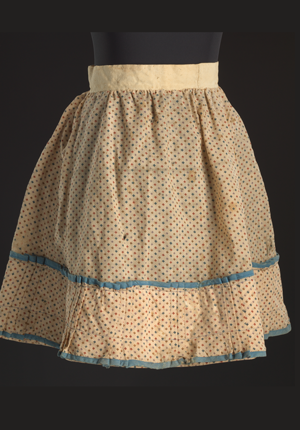Former slave’s skirt tells lawyers' family story in museum exhibit

Lucy Lee Shirley's skirt. Photo courtesy of the collection of the Smithsonian National Museum of African American History
Attorney Lori Anne Douglass already knew she came from a long line of strong women, starting with her great-great-grandmother Lucy Lee Shirley, who was born a slave. But Douglass, an estate law partner with Moses & Singer in New York City, learned a lot more about her ancestry when one of Shirley’s skirts became part of the “Slavery and Freedom” exhibit at the recently opened Smithsonian National Museum of African American History & Culture.
Douglass says Shirley’s sister made the skirt, and it had been passed down to her grandmother and donated to a museum in New York in the 1970s. From there, the skirt made its way to Washington, D.C.
By any measure, Shirley was a woman ahead of her time. Douglass says she learned from a Washington Post story that after Shirley died in 1929, she froze her abusive husband out of her will, leaving him $1 and her children $1,650, which would equate to about $23,000 today. It’s an unusual bequest for a woman in those times—and especially a former slave.
“A wife’s property [back then] automatically went to the husband,” Douglass says. “So she intentionally only left him a dollar and provided for her children.”
Douglass says it’s impressive that a former slave even had a will and could leave that amount of money to her descendants. Her brother, David Douglass, a litigation partner with Sheppard Mullin in D.C., also takes pride in his great-great-grandmother’s story.

Lori Anne Douglass. Photo Courtesy of Moses & Singer.
“She was standing up for her own rights in a system that was unfair to women. She left her children a fair amount of money,” he notes.
David Douglass says that Shirley’s pretty flowered skirt, though simple, shows slaves took pride in their appearance when they could, and the same kind of pride was often reflected in other aspects of their lives, such as cooking or farming.
He’s honored that his family will be part of this nation’s history, and what he appreciates most about the museum is that it doesn’t limit the identity of African-Americans to slavery alone.
The museum celebrates many aspects of the black American story, including exhibits that pay homage to African-Americans and the law. For example, there’s a print of Charlye Farris, the first black woman admitted to the Texas bar and the first to serve as a county judge in the South since Reconstruction.

David Douglass. Photo Courtesy of Sheppard Mullin.
There’s also a magazine cover from February 1917 featuring Richard T. Greener, the first African-American graduate of Harvard and a dean of the Howard University Law School.
“It’s all part of telling the story of who we were independent of the condition in which we came to this country,” says Douglass, who believes he’s also a descendant of famed abolitionist Frederick Douglass.
Lori Anne Douglass says her great-great-grandmother laid a foundation for her family that has benefited them for generations. And through the National Museum of African American History & Culture, a garment once worn by a slave now represents part of the fabric of the American story.
This article originally appeared in the February 2017 issue of the ABA Journal with this headline: "Lawyers Take Pride in Ancestry: Former slave’s skirt tells a family’s story in a national museum exhibit."



